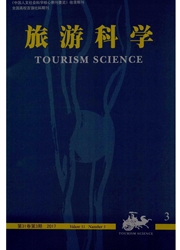

 中文摘要:
中文摘要:
本文通过整理面板数据并构建面板模型,分别以出游率、人均旅游花费与旅游购买力衡量旅游消费,引入虚拟变量区分收入水平与SARS危机的影响,从而揭示了收入对城市居民国内旅游消费的决定作用。模型估计结果表明:第一、对不同的旅游消费指标,收入的决定作用存在差异,其中,旅游购买力与出游率的收入弹性远大于人均旅游花费的收入弹性;第二、与低收入城市居民相比较,高收入城市居民国内旅游的出游率收入弹性减小,人均旅游花费收入弹性增大;第三、SARS对高收入城市居民国内旅游消费的负面影响更大。最后,根据面板数据的描述性统计结果与模型估计结果,从供给角度,建议在全国层次注重发展观光旅游,在旅游目的地层次注重细分目标市场。
 英文摘要:
英文摘要:
This paper summarized panel data and a panel model to evaluate the impact of the per capita disposable income on domestic travel rate,per capita tourist spending and per capita tourist consumption of urban residents by introducing dummy variables and SARS impacts.The results show that income elasticity of traveling rate is the largest,which means that with per capita disposable income growth,urban residents tend to travel more;compare to low-income urban residents,high-income urban residents tend to travel less and spend more;that SARS's negative influence on domestic tourist consumption of high income urban residents is bigger than that of low income urban residents.The paper ends with suggestions for emphasizing sightseeing tourism at national level and segmented target markets at destination level in light of descriptive findings panel data and the findings of model estimation.
 同期刊论文项目
同期刊论文项目
 同项目期刊论文
同项目期刊论文
 期刊信息
期刊信息
